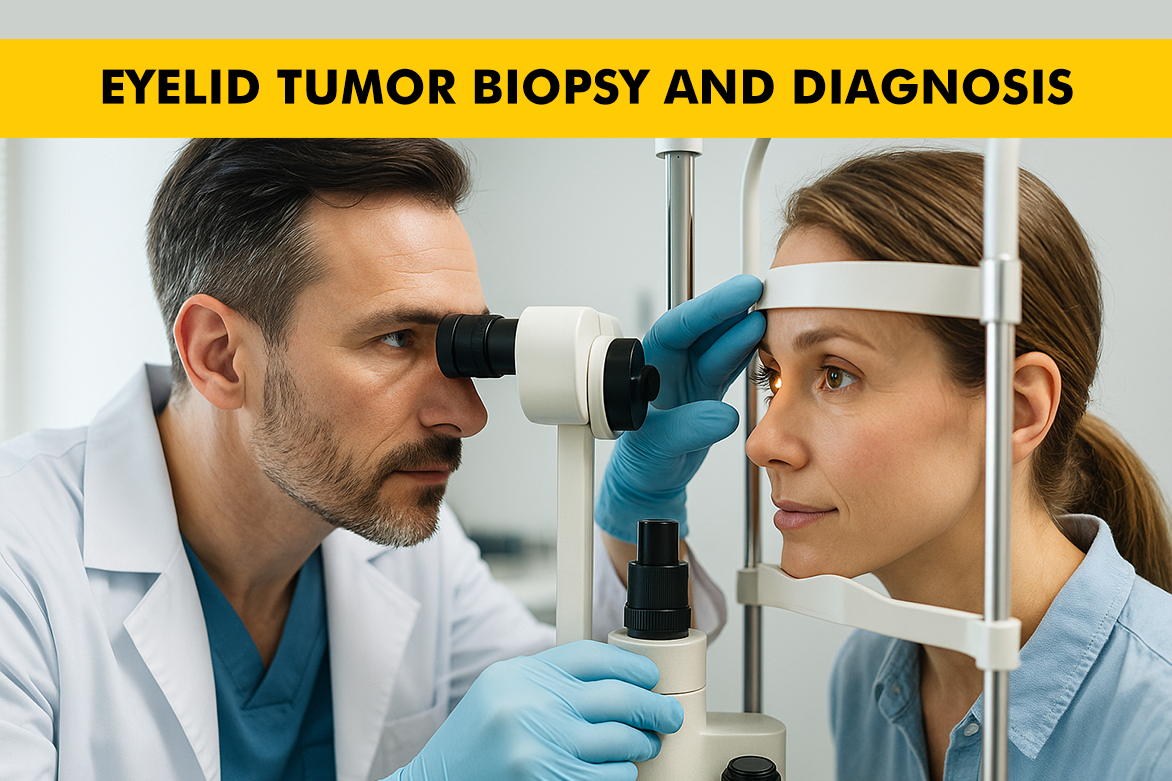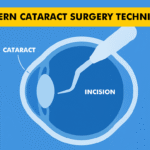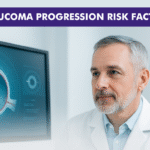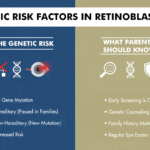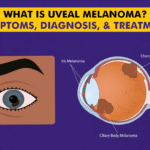Table of Contents
- Understanding Eyelid Tumors at a Glance
- Early Symptoms of Eyelid Tumour
- Why Is Early Detection of Eyelid Tumour Important?
- When Is a Biopsy Needed?
- What Happens During an Eyelid Biopsy?
- Post Eyelid Cancer Diagnosis: What Should You Expect?
- Understanding Your Eyelid Cancer Diagnosis Results
- Comparison of Eyelid Tumour Treatments and Outcomes
- Preventive Measures After Biopsy for Better Outcomes
Getting an eyelid tumor biopsy or eyelid cancer diagnosis can be scary and confusing. But you’re not alone—many people have questions and worries just like you. With the right information from the experts, you can feel more comfortable. This blog by Centre For Sight experts will provide you with a simple, honest explanation about eyelid tumour biopsy and help you understand what’s ahead, one step at a time.
Understanding Eyelid Tumors at a Glance
Eyelid tumors, while not extremely common, can range from harmless (benign) to potentially life-threatening (malignant). Early diagnosis and effective management make a tangible difference in outcomes. Here’s a comparative look at the main types:
Types of Eyelid Tumours
| Tumor Type | Prevalence | Key Characteristics | Typical Treatment | Common Age Group | Prognosis |
| Basal Cell Carcinoma | Most common | Pearly, firm edge, slow-growing, rarely painful | Surgical excision | >40 yrs | Excellent when treated early |
| Squamous Cell Carcinoma | Less common | Scaly/red bump, can ulcerate, may bleed | Surgery, sometimes radiation | >50 yrs | Good with prompt treatment |
| Sebaceous Gland Carcinoma | Rare | Yellowish, eyelash loss, often misdiagnosed | Surgery, sometimes radiation | >60 yrs (esp. women) | Can be aggressive, needs close monitoring |
| Benign Tumors (e.g. cysts) | Common | Well-defined, painless, slow-growing lumps | Observation /excision | All ages | Usually harmless |
Early Symptoms of Eyelid Tumour
Staying alert can be truly vision-saving. Symptoms to watch out for include:
- Persistent lump/swelling on the eyelid
- Eyelashes growing abnormally or falling out
- Redness, crusting, or a non-healing sore
- Itching, pain, or bleeding from the eyelid
- Gradual distortion or change of eyelid contour
- Unexplained change in skin color or thickness
A Patient Experience:
A patient noticed a small, painless nodule on her lower eyelid that didn’t resolve in months. She visited Centre For Sight, and the early eyelid tumour biopsy led to the discovery of a basal cell carcinoma, removed with surgery before it had spread. Regular awareness made all the difference.
Tip: Early eyelid cancer diagnosis is essential—most eyelid cancers, when diagnosed at an early stage, are curable and rarely threaten eyesight or life.
Why Is Early Detection of Eyelid Tumour Important?
Statistics reveal that over 90% of eyelid tumors, including cancers, are successfully managed when it is detected before spreading beyond the eyelid. Delays can lead to more complex treatments, higher costs, and affect your appearance or even your vision. Especially if you’re over 40 or have a personal/family cancer history, then regular eye check-ups are a must. Also, UV exposure is a major risk, so always wear protective eyewear and broad-brimmed hats outdoors.
When Is a Biopsy Needed?
Not every eyelid lesion is suspicious, but certain changes always require closer eyelid cancer diagnosis.
Criteria for an Eyelid Tumour Biopsy:
- The lesion grows over several weeks/months
- Persistent change in color/texture or spontaneous bleeding
- Non-response to standard therapy (e.g., antibiotics/ointments)
- Associated eyelash loss, inward/outward turning of the eyelid, or lid thickening
- Medical history of cancer or radiation
Clinical Fact:
According to an Indian Journal of Ophthalmology review, one in three patients with eyelid cancer waited more than 6 months before seeking specialist advice—a delay that led to more complex surgical procedures in over half the cases. Children can also develop benign but rarely malignant eyelid tumors; perseverance of any lesion warrants assessment regardless of age.
What Happens During an Eyelid Biopsy?
Understanding the eyelid tumour biopsy process can ease fears and clarify expectations. Step-by-Step Biopsy Procedure:
- Preparation:
You’ll be seated or reclined comfortably. The area is cleaned to prevent infection.
- Local Anesthesia:
A quick, gentle injection ensures the procedure is nearly painless—most report only mild pressure or tingling.
- Tissue Sampling:
- Punch biopsy removes a small core, ideal for minor lesions.
- Incisional biopsy takes a piece from a larger growth.
- Excisional biopsy removes the entire lesion if possible.
- Hemostasis (Bleeding Control):
Pressure or mild cautery stops bleeding.
- Wound Closure:
Small wounds are often left open to heal naturally, while larger ones may be closed with fine, nearly invisible sutures.
- Sample Processing:
The tissue is labelled, rushed to the lab, and analyzed by a pathologist.
- Duration:
The procedure normally lasts about 20–30 minutes.
Post Eyelid Cancer Dignosis: What Should You Expect?
Common Experiences After Biopsy
Swelling/Bruising: Mild; usually subsides within 2–5 days.
Mild Oozing or Discomfort: Easily managed with cool compresses and over-the-counter pain relief (paracetamol/acetaminophen).
Appearance: Small scabs may form—do not pick at them; makeup should be avoided until healing is complete.
Vision: Unaffected in most cases, but if it is blurry, consult your doctor.
Aftercare Checklist:
- Keep the area dry and clean as instructed
- Avoid rubbing, strenuous activities, or swimming for a week
- Apply prescribed ointment and take medicines exactly as advised
- Attend all follow-up appointments to discuss lab results
| Self-Care Task | Why It Matters | How Long? |
| Keep area clean/dry | Prevents infection | 3–5 days |
| Avoid eye makeup | Reduces irritation/infection | Until fully healed |
| Use cold compress | Minimizes swelling | As needed, first 2 days |
| Pain medication | For comfort | As needed |
| Attend follow-up | Ensure correct healing/treatment | As scheduled |
Possible Complications After Eyelid Tumour Biopsy
- Persistent bleeding (seek urgent care)
- Redness, increasing pain (possible infection)
- Delayed healing (consult an ophthalmologist)
Understanding Your Eyelid Cancer Diagnosis Results
Pathology results typically take 3–7 days. Here’s what to expect:
| Result | What It Means | Typical Next Step |
| Benign | Not cancerous, low risk | Monitor or remove if bothersome |
| Pre-cancerous | Some risk features | May need wider excision/removal |
| Malignant | Cancer detected | Surgery/possible oncology referral |
| Uncertain/Atypical | Results not clear | May repeat biopsy or further tests |
Comparison of Eyelid Tumour Treatments and Outcomes
| Tumor Type | Early Detection Treatment | Advanced Stage Treatment | Recurrence Rate | Long-Term Outlook |
| Basal Cell Carcinoma | Local excision | More extensive surgery | <5% | Excellent if caught early |
| Squamous Cell Carcinoma | Surgery/radiation | Surgery+chemo+radiation | Up to 10% | Good if prompt, but needs follow-up |
| Sebaceous Gland Carcinoma | Surgery; may need radiotherapy | Extensive surgery/chemo | 20%+ | Depends on spread |
| Benign Tumors | Local excision/observation | — | Rare | No impact if managed |
Did you know?
The most aggressive eyelid cancers, if caught before spreading, often require only local surgery and can preserve both vision and cosmetic appearance.
Preventive Measures After Biopsy for Better Outcomes
You are your best advocate. Better results hinge not just on the doctor, but on your active participation.
- Meticulously follow wound care: Reduces the risk of infection and poor healing.
- Don’t skip follow-ups: Some eyelid tumors have a risk of recurrence.
- Protect your eyes from UV rays: Regular use of sunglasses and sunscreen.
- Quit smoking: Smoking delays wound healing and increases cancer risk.
Conclusion
A diagnosis of an eyelid tumor can affect more than just your health—it also influences your appearance, self-confidence, and emotional well-being. Support from family, friends, and care teams plays a crucial role. At Centre For Sight, personalized, compassionate care addresses not just the medical, but also the psychological needs of every patient.
FAQs
- Is the biopsy painful?
No, a numbing injection ensures comfort during the procedure. Some feel mild pressure but no severe pain.
- Will I have a scar?
Surgical techniques for eyelid biopsies prioritize cosmetic outcomes. Most scars are barely visible after a few months.
- Do all eyelid tumors need a biopsy?
Only those with unusual appearance, growth, or unresponsiveness.
- How do I reduce my risk in the future?
Sun protection, annual exams, and not ignoring subtle changes are your best defense.
